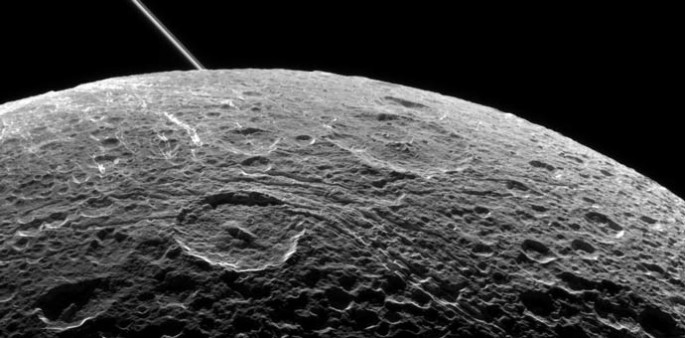NASA's Cassini spacecraft will provide scientists some never before seen, unprecedented views of Saturn's moon Dione when the probe zipped by the icy moon on Monday, August 17.
The spacecraft is expected to conduct a flyby where it will arrive at 295 miles from Dione's surface with the closest approach around 2:33 P.M. EDT as images of the moon's surface will be transmitted the following days.
This flyby is crucial for scientists as they are hoping to gain more scientific data about the moon's gravitational forces and its internal structure in order to make comparison with Saturn's other natural satellites.This gravity science investigation conducted by Cassini has only been performed on only a handful of moons, from the ringed planet's 62 known moons.
Using Cassini's suite of scientific instruments such as spectrometers and its camera, the probe will capture a high resolution image of Dione's northern polar region for the first time from a distance of only a few feet. Using Cassini's Composite Infrared Spectrometer instrument will also map the regions on the icy moon that have temperature spikes where heat is also trapped. Another instrument called the Cosmic Dust Analyzer will detect dust particle emissions from Dione.
Scientists have been curious about Dione's geological activity since Saturn's other moon, Enceladus has geysers.
According to Cassini science team member, Bonnie Buratti from NASA's Jet Propulsion Laboratory in California, Dione has always been regarded as an enigma since it is giving away clues of its otherwise geologic activity that includes a transient atmosphere and even evidence of ice volcanoes. Unfortunately, this fifth flyby will be the last flyby of Dione and hopefully, this will yield some crucial data.
To date, Cassini has been in orbit around Saturn for more than a decade now, where a series of close moon flybys were conducted this year before Cassini's final stage of its mission where it will now depart Saturn's equatorial plane. The final stage involves a daring maneuver where the spacecraft will repeatedly dive into the void between Saturn itself and its ring plane.




























